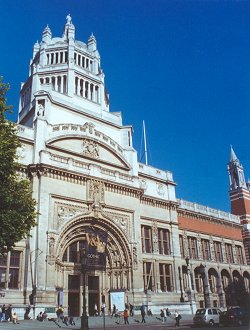Do not allow the fact that a museum is in a non-English speaking foreign country to stop you. The first important trick to know is that many foreign websites have a set of flags across the top of the page. The British flag is your friend – it means that they have at least some pages available in British English – just click on the flag. I should note that there are different definitions for some words between British and American English. Make sure that you learn the differences. Recently several of the museum sites have switched to a tab at the top of the page that says “language”. These drop-down menus let you choose the language that you want to see the site in.
Now, choosing the English language version of a site may not get you what you want. While a few of the sites have set up their data bases to function completely in English, many have not. Also, some sites may have a sort of “Readers Digest” version of the museum pages that ignores the information that you want. Be sure that you compare the foreign language version to the English version to see if they appear to cover the same information. If the English version has two pictures and 200 words and the Danish version has six pictures and 800 words, the pages are not the same. So then what do we do?
http://translate.google.com/# Google Translate
It will not be perfect, but you can usually figure out the information that you need. Sometimes you can just cut and paste sections of text into the translator, or ask it to translate an entire page.
Another solution is a variation on some of the original research techniques that I discussed at the beginning of this blog series. Make a list of the words that you need to know: iron, bronze, silver, bone, wool, amulet, bracelet, ring, time frames, locations – things like that. Choose the words that are relevant to whatever you are studying and make a list of the foreign words that you need to know. I often keep Google Translate open in one window and have the museum site open in another. I have spent a LOT of time in the Swedish National Museum database with a simple cheat sheet of artifact terms, and discovered some very good information. Is it as easy as dealing with a site in English? No. But if you want to get the accurate artifact information you need to learn to do this.
Here is a list of just a few of the foreign sites that are worth visiting.
http://www.dhm.de/datenbank/ Deutsches Historisches Museum Databank – This is actually a database that collects together artifact information from dozens of smaller museums all over Germany. Some of the information is very old, and some of these artifacts may not even exist anymore, having been destroyed in World War II, but they have some amazing artifact records.
http://www.libnet.ulg.ac.be/enlumin/enl01.htm Choix de miniatures des manuscrits de l’Université de Liège (French) – An amazing collection of manuscripts, many of which do not appear anywhere else.
http://mis.historiska.se/mis/sok/sok.asp Historika Museet – Swedish National Historical Museum (Swedish) – An amazing collection of thousands of artifacts from Sweden and some surrounding areas. Do NOT assume it is all Viking Age material – it is NOT. Be sure to learn the different timeframes and what they mean.
http://www.unimus.no/foto/old/fixedsize.html Photo Portal for Swedish Museums (Swedish) – A collection of artifacts from four Swedish Museums.
http://www.rijksmuseum.nl/?lang=en Rijks Museum in Holland (Dutch)
http://www.museodelprado.es/en/the-collection/online-gallery/ Musee Natcional del Prado (Spanish)
http://www.musee-renaissance.fr/index2.html National Museum of the Renaissance (French)
http://www.louvre.fr/selections The Louvre (French) – They have limited selections available online, but they are still pretty amazing to look at.
http://mv.vatican.va/3_EN/pages/MV_Home.html The Vatican museum Website. It is less user friendly than I would prefer, but I expect this to improve in the future. The Vatican is in the process of digitizing a huge portion of their collections in order to make them available to researchers.
I hope that this brief list of websites provides you with some sources, and some ideas of your own about where you can do research. If you discover an interesting artifact, and know what museum has it, Google the museum! You may be able to find a LOT more information about it through the museum.
Next Time: Communicating with Museums



